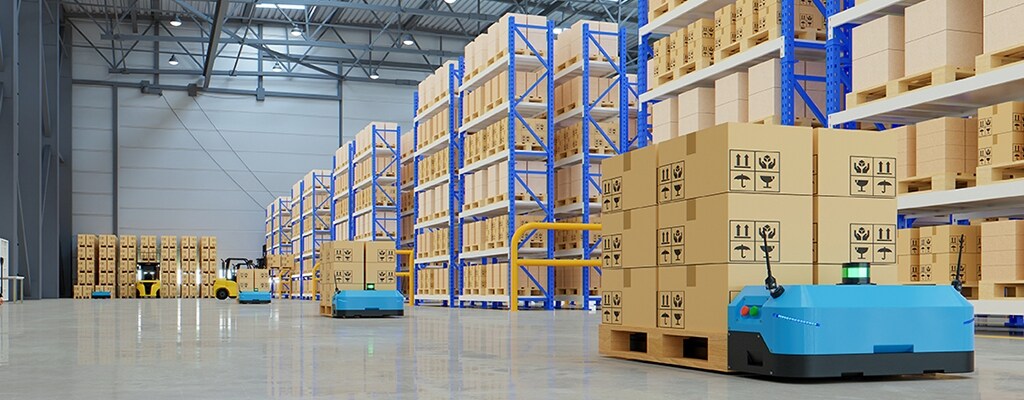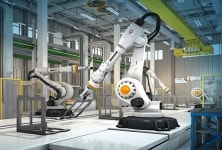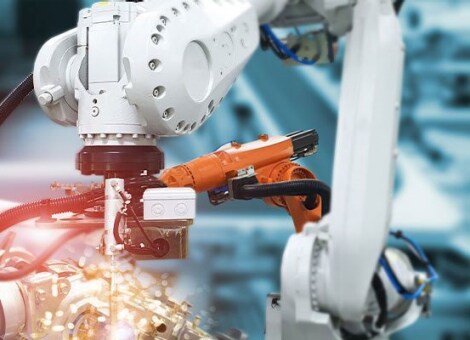
TE Perspective
Powering a Smarter Mobile Warehouse Robot
Lavanya Manohar, VP of strategy, marketing and business development, Automation and Connecting Living Sector
In warehouses around the world, autonomous robots are working alongside humans to ship goods faster than ever – and the demand for speed is only rising. With many retailers promising two-day shipping and a high volume of orders to fulfill, success depends on how much warehouses can automate the process of locating, picking, and packing goods. Initially, humans with bar code scanners had to navigate a warehouse, find the items in an order, and bring them back to the shipping area to pack them and send them on their way.
To accelerate this process, major retailers invested in robots that could move entire shelves of inventory across the warehouse to human shippers. As robotic technology became more intelligent and dexterous, warehouses were able to simplify the system by having robots pick items off shelves and put them on conveyor belts to get them to the shipping area.
The next phase in this evolution calls for fundamental change in how warehouse robots operate. Until now, systems have largely kept human and robot operations separate. The next generation of robots are being let out of their cages so that they can work in the same spaces as the humans around them. That shift requires a new focus on making those robots safer, smarter, smaller and more autonomous.
As the skills we equip robots with become more human-like in the areas of cognition, dexterity, adaptability and reasoning, the robots themselves will increasingly resemble humans in form-factor. The focus on the tasks those robots perform will shift as well, from human-robot collaboration initially to full robot autonomy down the road, when they will operate without humans in the loop. This forthcoming warehouse evolution has massive implications for connectivity, building automation, power and electrification.

Making Mobile Robots Safer and More Intelligent
As robots acquire more capabilities and take over more tasks in warehouses, we must ensure they operate safely and efficiently as they meet key objectives like faster delivery timelines.
To strike that balance, robots need advanced sensors, integrated safety systems and improved connectivity.
Robots will need upgraded sensors to produce human-like perception, dexterity and reasoning capabilities:
- For visualization, they will need LIDAR, vision, or infrared sensors to discern the world around them.
- To improve their reasoning, they will need stronger compute capabilities that can handle complex artificial intelligence and machine learning algorithms, including graphics processing units (GPUs) and neural processing units (NPUs).
- To interact cooperatively and effectively within a warehouse ecosystem, they will need improved connectivity to local and remote networks via Ethernet, RJ45, edge and/or cloud equipment and protocols.
- To operate safely around humans, they will need timers, encoders and torque sensors that help them keep movements within job-site specifications and override potentially unsafe activities.
- To provide power and keep batteries charged, they will need mating connectors and flexible docking systems capable of supporting autonomous recharging.
- They will also need motors and motion systems to make it possible to move freely and dexterously enough to undertake a widening range of actions throughout the warehouse.
Ensuring reliable and safe autonomous operation under all conditions – normal or harsh, day or night – is critical. In addition to being capable, sensors and connectivity solutions must also be durable. And as systems become more complex, the ability to self-diagnose potential maintenance issues by connecting to the cloud could save time and costs as warehouses work to keep their robotic fleets maintained.
Charging Capabilities are Critical
It’s hard to maximize a robot’s mobility without cutting the cord. But an autonomous robot that runs on batteries must be able to charge itself regularly to achieve peak efficiency. Enabling robots to dock with a charger and mate components securely without the need for human intervention is not a trivial challenge. Robots come in different sizes and shapes based on the task they are assigned. The loads they carry and the specific application they tackle vary depending on whether they pick or place or sort or search.
TE Connectivity’s charging solutions are designed to produce a solid connection while allowing enough tolerance for robots to manage the mating process autonomously. TE’s charging connectors are also tailored to the type of robot involved. For example, the charging connector for a robot that moves and shifts heavy pallets has different requirements than the blind mating charging connector used to charge automated mobile robots that pick individual products off the shelves.
In all cases, charging stations must be equipped with connectors that will work reliably in difficult and dirty environments. They also need line filters to ensure they transfer the appropriate amount of current to charge a robot efficiently. Both chargers and charging ports need to be built to withstand automated coupling and decoupling of parts many times – potentially across hundreds of thousands of mating cycles.
Smaller Components Mean More Flexibility
The tradeoff between size and capability is a constant concern among engineers. Nearly every manufacturer produces robots with a series of payloads, all of which have varying power requirements. In a cross-dock facility where there’s no need to deal with anything smaller than a pallet, operators can use very heavy robots with limited mobility. At the other end of the spectrum, robots capable of picking individual objects or even sorting medications in a pharmacy need to be much smaller.
At the same time, as space inside warehouses has become more limited and requires smaller robots, the power, signal and torque requirements for those robots have increased. To accommodate this need, component manufacturers like TE have been focused on producing more powerful and dependable parts in a smaller form factor. Highly specialized engineering and manufacturing capabilities will become increasingly important as component makers develop innovative products to suit a wide range of customer demands.
Preparing for a More Flexible Future
Further refinement of the movements that robots can make will allow them to take on a number of jobs that still require human intervention. For example, most warehouses still store items in larger quantities than a typical order size – like a box of 20 toothbrushes. That means a robot must bring the box to a shipping area, where a human picks out a single toothbrush for an order. Next-generation robots may be able to autonomously find and pick that one toothbrush. Similarly, grocery items that are fragile and perishable need even more dexterity, as well as the ability to intelligently manage pressure and torque so that a robot’s movements don’t risk damaging fragile objects like fruits and vegetables.
Processing power and the ability to navigate tight spaces quickly and safely will only become more important for warehouse robots that can perform these increasingly complex tasks. But the advances in component technology that continue to free robots from their cages and advance warehouse automation will pave the way for applications across other industries where robotic automation can enhance speed, power and safety. The pace at which robots take on new tasks in warehouses is only going to increase exponentially. As that happens, demand is also likely to rise for the components that power electrification, automation, sensing and mobility.
About the Author

Lavanya Manohar
Lavanya Manohar is the vice president of strategy, marketing and business development for TE Connectivity’s Automation and Connecting Living Sector. Drawing on over 15 years of experience in product, technology and consulting within the industrials space – across robotics, factory automation, warehouse automation, sensors and connectivity, she has successfully led digital transformations, built and launched successful AI-enabled products, acquired companies and managed large global teams. She holds an MBA from Harvard Business School and an engineering degree from the Indian Institute of Technology, Madras.
 e
e
 e
e
 e
e


